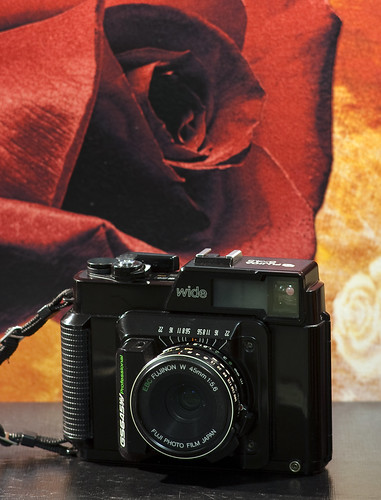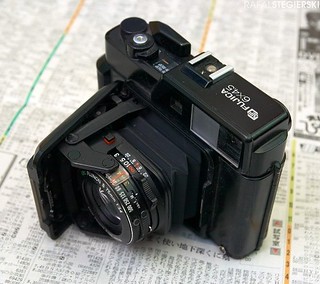Fuji GS645 Professional series
The Fuji GS645 series of compact medium format cameras was released in the early 1980's. They share a nearly identical body and have fixed lenses of three different focal lengths. The GS645 and GS645S use rangefinder focusing while the GS645W is scale focusing. They take 120 and 220 film using a 6 x 4.5 format and are known for very sharp lenses. The design of the cameras results in the viewfinder being in a portrait format orientation instead of the more common landscape format.
They feature a leaf shutter based design using a Copal #00 shutter with speeds of 1 to 1/500 of a sec. The built-in light meter is activated by pressing the shutter release button half way. The meter cell, based on a photo-diode, is in the viewfinder (i.e. it does not measure through the lens). The meter's ISO setting is adjusted on the lens barrel; its setting window is sandwiched between the aperture and shutter speed rings. The meter uses three LED lights; +, o and -; in the viewfinder to aid in exposure. The film transport is manually operated with a single stroke film advance lever on the top plate of the camera. Advancing the film also cocks the shutter. Surrounding the shutter release button is a release lock. A hot shoe is provided for external flash and can be synced at any shutter speed. The film counter is on the back of the top plate. These cameras are powered by 2x LR44 batteries located on the bottom base plate. A tripod mount is also provided.
| Meter display | |
|---|---|
| LED | status |
| + | 1 or more over |
| o and + | 1 over |
| o and + (half) | 1/3 over |
| o | correct exposure |
| o and - (half) | 1/3 under |
| o and - | 1 under |
| - | 1 or more under |
The camera back contains a film box reminder holder and a 120/220 indicator. Inside the back a pressure plate to switch between 120 and 220 film. Press and move the plate so the desired film type is indicated. When the cameras are loaded with 120 film it will produce 15 exposures, 220 will do 30 exposures and half roll 120 will produce 7 exposures. Loading the film is very easy with these cameras, with the back open; press the red spool release buttons. Remember the take up spool is located on the right, the same side as the film advance lever and the film is on the eyepiece side. Insert the spools using the top spindles and lock with the spool buttons. Draw the paper leader from the film side to the take up reel; inserting the head into the spool slot. Advance the film until the start mark on the film is lined up with the indicator on the body.
|
|
GS645

|
| GS645W image by Mustafa Dogan (Image rights) |
The Fujica GS645 Professional was released in March 1983[1] and is a folding rangefinder camera utilizing a bellows for focusing. It has a EBC Fujinon S 75mm f/3.4 lens comprised of 5 elements with the closest focus distance at 1m. Aperture stops on the lens include 22, 16, 11, 8, 5.6, 4, and 3.4. To open the camera pull the lock button on the front cover, and swing it till it locks with a snap. To close make sure the lens focus ring is set to infinity and the shutter is cocked. Press the knobs on the inside of the lens cover to release the lock and swing the cover towards the body. The light meter has a measuring range of 3.5 to 18 EV and can be set from 25 to 1600 ISO in 1/3 stops. The finder contains a coupled type double image rangefinder for focusing. A 0.63x magnification with a 39.5 mm baseline which is a 24.9 mm effective baseline. Bright lines are present with automatic parallax correction to assist in framing. The camera measures 147mm x 114mm x 122mm (width x height x depth) when unfolded. When folded, the depth is just 56mm. It weighs 820 g without batteries.
GS645W
The Fujica GS645W Professional Wide was released in October 1983[1] and is a viewfinder camera with scale focusing. It uses an EBC Fujinon W 45mm f/5.6 lens comprised of 6 elements. The camera was thought to complement a 35mm or 4x5 camera for on location shooting, especially landscape and mountain photographs. For this reason Fuji also selected the 45mm lens.[1] It is a 35mm equivalent to 28mm. Filters of 49mm can be used. Aperture stops on the lens include 22, 16, 11, 8 and 5.6. The light meter has a measuring range of 3.5 to 18 EV and can be set from 25 to 1600 ISO in 1/3 stops. The viewfinder has a bright frame and parallax correction indicator, it has a 0.45x magnification. Scale focusing is used on the GS645W lens with a range of 1m to inf. with markings at 1, 1.2, 1.5, 2, 3, 5, 10 meters and inf. Click stops at 2 and 5 meter markings. The viewfinder is a reverse Galilean type with a parallax correction indicator. A 0.45x magnification with a 90% field of view at 1m, and 87% at inf.
GS645S
The Fuji GS645S Professional Wide60 was released 1 October 1984 and is a rangefinder camera that uses a newly-designed EBC Fujinon W 60mm f/4 Orthometar-type lens comprised of 7 elements in 5 groups, mounted in a mechanical Copal 00 shutter[1]. The 60mm lens was chosen with snapshots in the city, or group pictures in mind, for which Fuji received user feedback saying the 45mm was too wide.[1] The lens is a 35mm equivalent to 35mm, with a 49mm filter thread. Aperture stops on the lens include 22, 16, 11, 8, 5.6, and 4. In the case of the S version it is protected by a circular "cow bar". The light meter has a measuring range of 4 to 18 EV and can be set from 25 to 1600 ISO in 1/3 stops. The finder contains a coupled type double image rangefinder for focusing. A 0.5x magnification with a 40 mm baseline which is a 20 mm effective baseline. Bright lines are present with automatic parallax correction to assist in framing. Together with the GS645S Fuji released the GS-grip, to be able to turn a flash 90 degrees and avoid vignetting of the vertical film frame. There is also space to store one medium format film inside the grip[1]
Fuji GS645 specification matrix
| Fujica GS645 | Fujica GS645W | Fuji GS645S | |
|---|---|---|---|
| Introduction | 1983 | 1984 | |
| Type | folding | non-folding | |
| Lens | 75mm f/3.4 | 45mm f/5.6 | 60mm f/4 |
| Aperture | 22, 16, 11, 8, 5.6, 4, and 3.4 | 22, 16, 11, 8 and 5.6 | 22, 16, 11, 8, 5.6, and 4 |
| Focus | rangefinder | scale | rangefinder |
| Finder | 0.63x | 0.45x | 0.5x |
Bibliography
- Lewis, Gordon, ed. The History of the Japanese Camera. Rochester, N.Y.: George Eastman House, International Museum of Photography & Film, 1991. ISBN 0-935398-17-1 (paper), 0-935398-16-3 (hard). P. 173.
- Omoide no supuringu-kamera-ten (思い出のスプリングカメラ展, Exhibition of beloved self-erecting cameras). Tokyo: JCII Camera Museum, 1992. (Exhibition catalogue, no ISBN number.) P. 8.
- Sugiyama, Kōichi (杉山浩一); Naoi, Hiroaki (直井浩明); Bullock, John R. The Collector's Guide to Japanese Cameras. 国産カメラ図鑑 (Kokusan kamera zukan). Tokyo: Asahi Sonorama, 1985. ISBN 4-257-03187-5. Items 1312–3.
Notes
Links
- Fuji GS645 Professional user manual at Butkus.org
- Fuji GS645W Professional user manual at Butkus.org
- Fuji GS645S Professional user manual at Butkus.org
- GS645S Brochure (also covers the other two models briefly) at Pacific Rim Camera
- Fujica GS645 Flickr group
In French and English:
- Fuji GS645 on www.collection-appareils.com by Sylvain Halgand
In Polish:
- Fuji Ka? Fujica! on www.stegierski.com by Rafał Stęgierski

